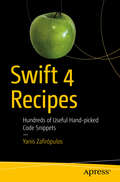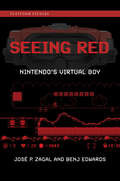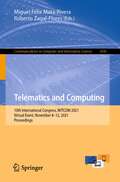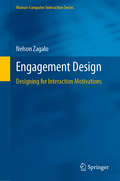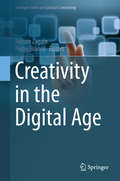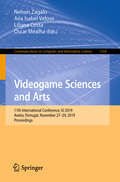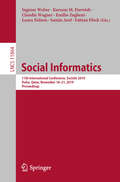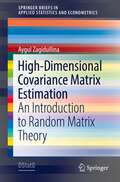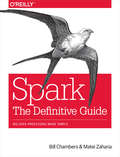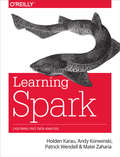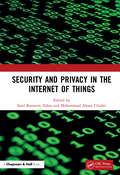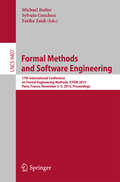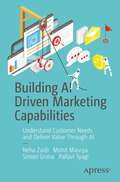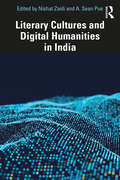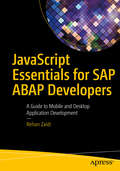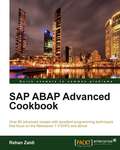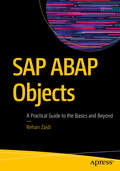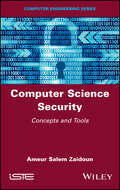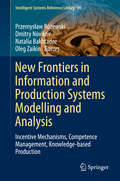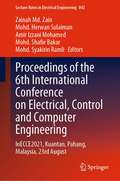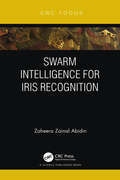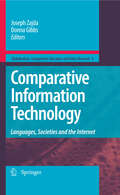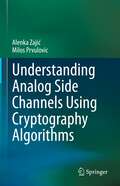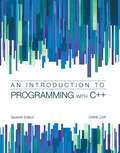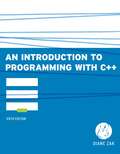- Table View
- List View
Swift 4 Recipes
by Yanis ZafirópulosGet the most out of Swift 4 with this carefully compiled collection of select code snippets designed to solve everyday coding problems. This book features the Apress easy-to-use recipe format, with step-by-step instructions, and a no-fuss approach. You'll explore a wide range of topics, all neatly organized according to the language’s own core elements and building blocks. You'll review common topics such as conditionals, loops, functions, classes, closures, and arrays. This book also includes recipes to some more advanced problems found in files, system programming, and algorithms. With Swift 4 Recipes, your programming problems are easily resolved, without wading through paragraphs of text. What You'll LearnCreate if-switch statements, ternary operator, and nil-coalescing Work with numbers, conversions, mathematical functions Access the command line and retrieving system infoWho This Book Is ForMac and iOS developers either looking for a quick problem-solution manual to get started or in search of a quick reference for everyday problems in a dictionary-like fashion.
Seeing Red: Nintendo's Virtual Boy (Platform Studies)
by Jose P. Zagal Benj EdwardsThe curious history, technology, and technocultural context of Nintendo&’s short-lived stereoscopic gaming console, the Virtual Boy.With glowing red stereoscopic 3D graphics, the Virtual Boy cast a prophetic hue: Shortly after its release in 1995, Nintendo's balance sheet for the product was "in the red" as well. Of all the innovative long shots the game industry has witnessed over the years, perhaps the most infamous and least understood was the Virtual Boy. Why the Virtual Boy failed, and where it succeeded, are questions that video game experts José Zagal and Benj Edwards explore in Seeing Red, but even more interesting to the authors is what the platform actually was: what it promised, how it worked, and where it fit into the story of gaming.Nintendo released the Virtual Boy as a standalone table-top device in 1995—and quickly discontinued it after lackluster sales and a lukewarm critical reception. In Seeing Red, Zagal and Edwards examine the device's technical capabilities, its games, and the cultural context in the US in the 1990s when Nintendo developed and released the unusual console. The Virtual Boy, in their account, built upon and extended an often-forgotten historical tradition of immersive layered dioramas going back 100 years that was largely unexplored in video games at the time. The authors also show how the platform's library of games conveyed a distinct visual aesthetic style that has not been significantly explored since the Virtual Boy's release, having been superseded by polygonal 3D graphics. The platform's meaning, they contend, lies as much in its design and technical capabilities and affordances as it does in an audience's perception of those capabilities. Offering rare insight into how we think about video game platforms, Seeing Red illustrates where perception and context come, quite literally, into play.
Telematics and Computing: 10th International Congress, WITCOM 2021, Virtual Event, November 8–12, 2021, Proceedings (Communications in Computer and Information Science #1430)
by Roberto Zagal-Flores Miguel Félix Mata-RiveraThis book constitutes the thoroughly refereed proceedings of the 10th International Congress on Telematics and Computing, WITCOM 2021, held in November 2021. Due to the COVID-19 pandemic the conference was held online. The 12 full papers and 7 short papers in this volume were carefully reviewed and selected from 48 submissions. The papers are focused on the topics of deep and machine learning, cybersecurity, wireless networks, computer vision, communications, and education applied to different sceneries of study and COVID-19.
Engagement Design: Designing for Interaction Motivations (Human–Computer Interaction Series)
by Nelson ZagaloInteractive media designers have been discussing modes to optimize interaction design beyond mere usability. With the arrival of Emotional Design followed by the success of the User Experience (UX) approaches, the discussion continued and augmented. Experience has become a complex buzzword, which is more about the subject’s experience than the product, and this is why it's difficult, or even impossible, to define it in a concise manner. We propose to move the discussion from Experience towards Engagement, to emphasize the design of the relationship between artefacts, contexts and users. Engagement asks for a more concrete type of experience, with specific needs, motives, skills and competences, which can be more clearly worked into the design of artefacts. Engagement also differs from other concepts e.g. fun, enjoyment, happiness or well-being and is open enough to grant freedom to designers in creating their personal world views. To push this new approach, we offer in this book a full model for the design of engagement in interactive media, still believing it can be applied beyond that. The model is arranged around what we call the three engagement streams: Progression, Expression and Relation.
Creativity in the Digital Age (Springer Series on Cultural Computing)
by Nelson Zagalo Pedro BrancoThis edited book discusses the exciting field of Digital Creativity. Through exploring the current state of the creative industries, the authors show how technologies are reshaping our creative processes and how they are affecting the innovative creation of new products. Readers will discover how creative production processes are dominated by digital data transmission which makes the connection between people, ideas and creative processes easy to achieve within collaborative and co-creative environments. Since we rely on our senses to understand our world, perhaps of more significance is that technologies through 3D printing are returning from the digital to the physical world. Written by an interdisciplinary group of researchers this thought provoking book will appeal to academics and students from a wide range of backgrounds working or interested in the technologies that are shaping our experiences of the future.
Videogame Sciences and Arts: 11th International Conference, VJ 2019, Aveiro, Portugal, November 27–29, 2019, Proceedings (Communications in Computer and Information Science #1164)
by Nelson Zagalo Ana Isabel Veloso Liliana Costa Óscar MealhaThis book constitutes the refereed proceedings of the 11th International Conference on Videogame Sciences and Arts, VJ 2019, held in Aveiro, Portugal, in November 2019. The 20 full papers presented were carefully reviewed and selected from 50 submissions. They were organized in topical sections named: Games and Theories; Table Boards; eSports; Uses and Methodologies; Game Criticism.
Social Informatics: 11th International Conference, SocInfo 2019, Doha, Qatar, November 18–21, 2019, Proceedings (Lecture Notes in Computer Science #11864)
by Emilio Zagheni Fabian Flöck Ingmar Weber Kareem M. Darwish Claudia Wagner Laura Nelson Samin ArefThis volume constitutes the proceedings of the 11th International Conference on Social Informatics, SocInfo 2019, held in Doha, Qatar, in November 2019. The 17 full and 5 short papers presented in these proceedings were carefully reviewed and selected from 86 submissions. The papers presented in this volume cover a broad range of topics, ranging from the study of socio-technical systems, to computer science methods to analyze complex social processes, as well as social concepts in the design of information systems.
High-Dimensional Covariance Matrix Estimation: An Introduction to Random Matrix Theory (SpringerBriefs in Applied Statistics and Econometrics)
by Aygul ZagidullinaThis book presents covariance matrix estimation and related aspects of random matrix theory. It focuses on the sample covariance matrix estimator and provides a holistic description of its properties under two asymptotic regimes: the traditional one, and the high-dimensional regime that better fits the big data context. It draws attention to the deficiencies of standard statistical tools when used in the high-dimensional setting, and introduces the basic concepts and major results related to spectral statistics and random matrix theory under high-dimensional asymptotics in an understandable and reader-friendly way. The aim of this book is to inspire applied statisticians, econometricians, and machine learning practitioners who analyze high-dimensional data to apply the recent developments in their work.
Spark: Big Data Processing Made Simple
by Matei Zaharia Bill ChambersLearn how to use, deploy, and maintain Apache Spark with this comprehensive guide, written by the creators of the open-source cluster-computing framework. With an emphasis on improvements and new features in Spark 2.0, authors Bill Chambers and Matei Zaharia break down Spark topics into distinct sections, each with unique goals.You’ll explore the basic operations and common functions of Spark’s structured APIs, as well as Structured Streaming, a new high-level API for building end-to-end streaming applications. Developers and system administrators will learn the fundamentals of monitoring, tuning, and debugging Spark, and explore machine learning techniques and scenarios for employing MLlib, Spark’s scalable machine-learning library.Get a gentle overview of big data and SparkLearn about DataFrames, SQL, and Datasets—Spark’s core APIs—through worked examplesDive into Spark’s low-level APIs, RDDs, and execution of SQL and DataFramesUnderstand how Spark runs on a clusterDebug, monitor, and tune Spark clusters and applicationsLearn the power of Structured Streaming, Spark’s stream-processing engineLearn how you can apply MLlib to a variety of problems, including classification or recommendation
Learning Spark
by Matei Zaharia Andy Konwinski Patrick Wendell Holden KarauData in all domains is getting bigger. How can you work with it efficiently? This book introduces Apache Spark, the open source cluster computing system that makes data analytics fast to write and fast to run. With Spark, you can tackle big datasets quickly through simple APIs in Python, Java, and Scala.Written by the developers of Spark, this book will have data scientists and engineers up and running in no time. You'll learn how to express parallel jobs with just a few lines of code, and cover applications from simple batch jobs to stream processing and machine learning.Quickly dive into Spark capabilities such as distributed datasets, in-memory caching, and the interactive shellLeverage Spark's powerful built-in libraries, including Spark SQL, Spark Streaming, and MLlibUse one programming paradigm instead of mixing and matching tools like Hive, Hadoop, Mahout, and StormLearn how to deploy interactive, batch, and streaming applicationsConnect to data sources including HDFS, Hive, JSON, and S3Master advanced topics like data partitioning and shared variables
Security and Privacy in the Internet of Things
by Syed Rameem Zahra Mohammad Ahsan ChishtiThis book provides a comprehensive study of the security and privacy research advancements in Internet of Things (IoT). The book lays the context for discussion by introducing the vulnerable intrinsic features of IoT. By providing a comprehensive discussion of the vulnerable features, the book highlights the problem areas of IoT related to security and privacy. • Covers all aspects of security • Algorithms, protocols and technologies used in IoT have been explained and the security flaws in them analyzed with solutions • Discusses ways for achieving better access control and trust in the IoT ecosystem • Contributes exhaustive strategic plans to deal with security issues of IoT • Gathers contributions from leading-edge researchers from academia and industry Graduates, researchers, people from the industry and security professionals who want to explore the IoT security field will find this book useful. The book will give an in-depth insight in to what has happened, what new is happening and what opportunities exist in the field.
Formal Methods and Software Engineering
by Fatiha Zaïdi Sylvain Conchon Michael ButlerThis book constitutes the refereed proceedings of the 17th International Conference on Formal Engineering Methods, ICFEM 2015, held in Paris, France, in November 2015. The 27 revised full papers presented were carefully reviewed and selected from 82 submissions. The papers cover a wide range of topics in the area of formal methods and software engineering and are devoted to advancing the state of the art of applying formal methods in practice. They focus in particular on combinations of conceptual and methodological aspects with their formal foundation and tool support.
Building AI Driven Marketing Capabilities: Understand Customer Needs and Deliver Value Through AI
by Neha Zaidi Mohit Maurya Simon Grima Pallavi TyagiThis book provides insight into technologies that offer competitive advantage in marketing. These technologies can help us with describing and predicting customer behavior with the help of analytics, designing of radical products, creating of meaningful value, optimization of distribution, informing and promoting solutions, and making marketing more effective overall by aligning marketing with business goals. A range of technologies, such as analytics, big data, artificial intelligence, IoT, machine learning are expected to transform future businesses. Understanding customer needs, matching them to solutions and delivering value can all be dramatically optimized with the help of technology. Businesses need to realize that AI has already made inroads in marketing and can be expected to wield its influence across functional areas in the foreseeable future. The business world is headed towards acceptance of technology to synthesize knowledge by interpreting diverse information and facilitating decision making.This book is an attempt to reflect deployment of technologies across businesses and sectors. As the functional discipline comes together, harnessing a gamut of technologies becomes indispensable to deliver a superior customer experience and driving profits. Marketers should thus adopt the concepts of openness, convergence, and creation of value through new emerging technologies. A resultant hyper connected market will thus have to adopt innovative changes in its existing processes and services. The proposed book offers its readers an insight into technological interventions in various aspects of marketing domain. From understanding various technologies as an enabler to marketing efforts and its impact on decision making and mapping of various facets of customer experience, this book is recommended for marketers and learners to understand the advantages of using technology. What You Will LearnThe developments and applications of Artificial Intelligence in marketingThe precise, practical framework necessary to discover, utilize, and embrace AI potential to optimize the outcomes for company growthAutomation and optimization of media planning through AIWho This Book is ForThe book is designed for marketers, academicians, business professionals, data scientists, practitioners, and researchers.
Literary Cultures and Digital Humanities in India
by Nishat Zaidi A. Sean PueThis book explores the use of digital humanities (DH) to understand, interpret, and annotate the poetics of Indian literary and cultural texts, which circulate in digital forms — in manuscripts — and as oral or musical performance. Drawing on the linguistic, cultural, historical, social, and geographic diversity of Indian texts and contexts, it foregrounds the use of digital technologies — including minimal computing, novel digital humanities research and teaching methodologies, critical archive generation and maintenance — for explicating poetics of Indian literatures and generating scholarly digital resources which will facilitate comparative readings. With contributions from DH scholars and practitioners from across India, the United States, the United Kingdom, and more, this book will be a key intervention for scholars and researchers of literature and literary theory, DH, media studies, and South Asian Studies.
JavaScript Essentials for SAP ABAP Developers
by Rehan ZaidiEasily master JavaScript (JS) with this quick guide and develop mobile and desktop applications for SAP Fiori. This book equips ABAP/SAP developers with the essential topics to get started with JS. The focus of JavaScript Essentials for SAP ABAP Developers is on the parts of the JS language that are useful from the perspective of an ABAP developer. The book starts with a brief intro to HTML, the basics of JS, and how to create and run a simple JS program. It then dives into the details of the language, showing how to make simple programs. It covers loops in detail, mathematical operations, and string and regular expressions in JS, as well as a taste of functions, followed by objects and object-oriented programming in JavaScript. The book provides: Sample code and screenshots to help you fully understand JS A chapter on JS best practices and recommendations Differences and comparisons of the elements and data structures of ABAP and JavaScript to help you quickly master the material What You'll Learn Create and run a simple JavaScript program Understand loops, operations, and expressions Master the Create and Use functions Use objects and object-oriented programming in JS Apply the best practices of JS programming Who This Book Is For SAP programmers and developers, ABAP users and developers, and university students learning ABAP and JavaScript
SAP ABAP Advanced cookbook
by Rehan ZaidiThis book is written in simple, easy to understand format with lots of screenshots and step-by-step explanations. If you are an ABAP developer and consultant looking forward to build advanced SAP programming applications with ABAP, then this is the best guide for you. Basic knowledge of ABAP programming would be required.
SAP ABAP Objects: A Practical Guide to the Basics and Beyond
by Rehan ZaidiUnderstand ABAP objects—the object-oriented extension of the SAP language ABAP—in the latest release of SAP NetWeaver 7.5, and its newest advancements. This book begins with the programming of objects in general and the basics of the ABAP language that a developer needs to know to get started. The most important topics needed to perform daily support jobs and ensure successful projects are covered. ABAP is a vast community with developers working in a variety of functional areas. You will be able to apply the concepts in this book to your area. SAP ABAP Objects is goal directed, rather than a collection of theoretical topics. It doesn't just touch on the surface of ABAP objects, but goes in depth from building the basic foundation (e.g., classes and objects created locally and globally) to the intermediary areas (e.g., ALV programming, method chaining, polymorphism, simple and nested interfaces), and then finally into the advanced topics (e.g., shared memory, persistent objects). You will know how to use best practices to make better programs via ABAP objects. What You’ll LearnKnow the latest advancements in ABAP objects with the new SAP Netweaver systemUnderstand object-oriented ABAP classes and their componentsUse object creation and instance-methods callsBe familiar with the functions of the global class builderBe exposed to advanced topicsIncorporate best practices for making object-oriented ABAP programs Who This Book Is For ABAP developers, ABAP programming analysts, and junior ABAP developers. Included are: ABAP developers for all modules of SAP, both new learners and developers with some experience or little programming experience in general; students studying ABAP at the college/university level; senior non-ABAP programmers with considerable experience who are willing to switch to SAP/ABAP; and any functional consultants who want or have recently switched to ABAP technical.
Computer Science Security: Concepts and Tools
by Ameur Salem ZaidounThis book serves as a guide to help the reader develop an awareness of security vulnerabilities and attacks, and encourages them to be circumspect when using the various computer resources and tools available today. For experienced users, Computer Science Security presents a wide range of tools to secure legacy software and hardware.Computing has infiltrated all fields nowadays. No one can escape this wave and be immune to security attacks, which continue to evolve, gradually reducing the level of expertise needed by hackers.It is high time for each and every user to acquire basic knowledge of computer security, which would enable them to mitigate the threats they may face both personally and professionally. It is this combined expertise of individuals and organizations that will guarantee a minimum level of security for families, schools, the workplace and society in general.
New Frontiers in Information and Production Systems Modelling and Analysis
by Oleg Zaikin Natalia Bakhtadze Dmitry Novikov Przemysław RóżewskiThis book demonstrates how to apply modern approaches to complex system control in practical applications involving knowledge-based systems. The dimensions of knowledge-based systems are extended by incorporating new perspectives from control theory, multimodal systems and simulation methods. The book is divided into three parts: theory, production system and information system applications. One of its main focuses is on an agent-based approach to complex system analysis. Moreover, specialised forms of knowledge-based systems (like e-learning, social network, and production systems) are introduced with a new formal approach to knowledge system modelling. The book, which offers a valuable resource for researchers engaged in complex system analysis, is the result of a unique cooperation between scientists from applied computer science (mainly from Poland) and leading system control theory researchers from the Russian Academy of Sciences' Trapeznikov Institute of Control Sciences.
Proceedings of the 6th International Conference on Electrical, Control and Computer Engineering: InECCE2021, Kuantan, Pahang, Malaysia, 23rd August (Lecture Notes in Electrical Engineering #842)
by Zainah Md. Zain Mohd. Herwan Sulaiman Amir Izzani Mohamed Mohd. Shafie Bakar Mohd. Syakirin RamliThis book presents the proceedings of the 6th International Conference on Electrical, Control and Computer Engineering (InECCE 2021), held in Kuantan, Pahang, Malaysia, on 23 August 2021. The topics covered are sustainable energy, power electronics and drives and power engineering including distributed/renewable generation, power system optimization, artificial/computational intelligence, smart grid, power system protection and machine learning energy management and conservation. The book showcases some of the latest technologies and applications developed to solve local energy and power problems in order to ensure continuity, reliability and security of electricity for future generations. It also links topics covered the sustainable developed goals (SDGs) areas outlined by the United Nation for global sustainability. The book will appeal to professionals, scientists and researchers with experience in industry.
Swarm Intelligence for Iris Recognition
by Zaheera Zainal AbidinIris recognition is one of the highest accuracy techniques used in biometric systems. The accuracy of the iris recognition system is measured by False Reject Rate (FRR), which measures the authenticity of a user who is incorrectly rejected by the system due to changes in iris features (such as aging and health condition) and external factors that affect iris image, for instance, high noise rate. External factors such as technical fault, occlusion, and source of lighting that causes the image acquisition to produce distorted iris images create error, hence are incorrectly rejected by the biometric system. FRR can be reduced using wavelets and Gabor filters, cascaded classifiers, ordinal measures, multiple biometric modalities, and a selection of unique iris features. Nonetheless, in the long duration of the matching process, existing methods were unable to identify the authenticity of the user since the iris structure itself produces a template changed due to aging. In fact, the iris consists of unique features such as crypts, furrows, collarette, pigment blotches, freckles, and pupils that are distinguishable among humans. Earlier research was done by selecting unique iris features. However, these had low accuracy levels. A new way of identifying and matching the iris template using the nature-inspired algorithm is described in this book. It provides an overview of iris recognition that is based on nature-inspired environment technology. The book is useful for students from universities, polytechnics, community colleges; practitioners; and industry practitioners.
Comparative Information Technology: Languages, Societies and the Internet (Globalisation, Comparative Education and Policy Research #4)
by Joseph Zajda Donna GibbsThis volume offers a critique of the nexus between ICT and its impact on society, individuals and educational institutions. One of the most significant dimensions of globalisation has been the rapid development of information and communications technologies (ICTs). Our lives have been changed by ICTs in numerous ways and the implications for education are enormous. The ICTs have transformed the linguistic, cognitive and visual dimensions of human communication, as well as our perceptions of the self, and social identity in the global culture. They have facilitated the development of new dimensions of digital literacy, such as blogging and sms messaging. In this sense, cyberlanguage continues to evolve by borrowing and adapting familiar words, coining new expressions, and embracing particular styles. The book provides directions in education and policy research, relevant to transformational educational reforms in the 21st century.
Understanding Analog Side Channels Using Cryptography Algorithms
by Alenka Zajić Milos PrvulovicThis book offers the latest research results on analog side channels and their usage in cybersecurity. It demystifies analog side channels and demonstrates new use cases for them. The first part of this book discusses how analog side channels are generated, the physics behind it, the modeling and measurements of analog side channels, and their analogies to wireless communication systems. The second part of this book introduces new applications that benefit from leveraging side channels. In addition to breaking cryptography algorithms, it demonstrates how analog side channels can be used for malware detection, program profiling, hardware profiling, hardware/software attestation, hardware identification, and hardware Trojan detection.Side channel is one of the methods for obtaining information about program execution. Traditionally, they are used in computer science to extract information about a key in cryptographic algorithms. What makes them different from other ways of extracting information about program execution is that side channels rely on how a system implements program execution, rather than what the program’s algorithm specifies. Analog side channels are particularly powerful because they are not easy to suppress or detect that someone is collecting information from the system. Although they are very powerful tools, they are poorly understood.This book targets advanced level students in computer science and electrical engineering as a textbook. Researchers and professionals working with analog side channels, how to model them, measure them, improve signal to noise ratio, and invent new signal processing techniques can also use this book. Computer scientists and engineers who want to learn new applications of side channels to improve system security, new techniques for breaking cryptography keys, new techniques for attestation, and new techniques for hardware Trojan detection will also want to purchase this book.
An Introduction to Programming with C++ (6th Edition)
by Diane ZakAn Introduction to Programming with C++, Sixth Edition is the latest C++ offering from Diane Zak. This book is distinct from other textbooks because of its unique approach, which motivates students by demonstrating why they need to learn the concepts and skills presented. Each chapter contains Mini-Quizzes, Labs, and Try This features to help readers practice and absorb the content as they go along. This edition also includes completely new applications and exercises, more IPO charts and flowcharts, and a brand new interior design.
